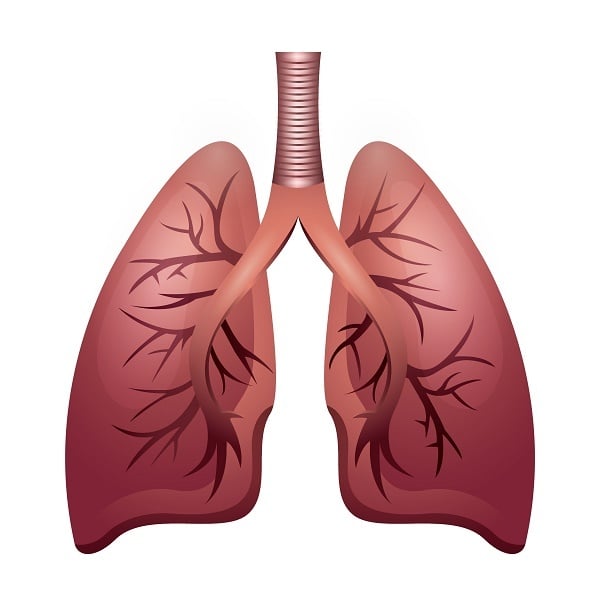Since one of my primary goals is to help you create a healthy home, I try to share information on all aspects of your family’s health. In honor of Lung Cancer Awareness Month, I’d like to shine the light on how your environment affects your lung health.

Many factors in our environment, both outdoors and in our own homes, can have an impact on our lung health whether we realize it or not. Some examples:
Asbestos
Asbestos is a natural fiber that has been mined for centuries for use in construction and household products. Once people discovered its fire resistant properties and durability, it became very popular.
The problem with asbestos is that it has been linked to several serious diseases.
- Mesothelioma – a rare, aggressive cancer with different types, but 75% of all cases occur in the lining of the lungs.
- Asbestosis – a chronic lung disease that results from lung tissue scarring
- Lung cancer – typically diagnosed at a late stage after the onset of symptoms
Asbestos has been banned in 52 countries, but not the United States, so education is important to help for a ban and further prevent this disease!
Where to find asbestos:
- If your house was built before the 1960s, chances are it has asbestos somewhere; asbestos was a common component of construction in shingles, insulation, flooring, drywall, etc.
- Veterans are actually 1 in 3 diagnoses of mesothelioma because asbestos was widely used in shipyards and military vessels
- Asbestos can be found in some car parts, like brake pads and gaskets–so those working on cars and any tradesmen are at risk of exposure
- Because of its properties, asbestos is sometimes used in specialty clothing and textiles, like fire blankets, gloves for those working with high heat, etc.
- Various products might also contain asbestos, like hair dryers, fume hoods, baby powder, and ironing board covers
- Second hand exposure is also a concern, so be aware if you have family in jobs that might handle asbestos (like construction, firemen, tradesmen, veterans)
Radon
Many people are aware of radon, but most of us forget about it after the initial test is performed on a new home. It’s worth thinking about though since radon is the #1 cause of lung cancer among non-smokers.
Radon is a colorless, odorless gas that forms naturally from the decay of radioactive elements found in the soil and earth. Radon is given off by rocks and soil, which then enters buildings through cracks in the foundation, any gaps around wires or pumps, cracks in floors or ceilings; the levels are usually the highest in the basement.
Exposure can also occur from building materials, like concrete and some granite countertops.
To prevent radon exposure make sure any cracks in your home are sealed, increase ventilation in the home, and have regular testing done for radon.
Household Cleaning Products
Even more relevant to most of us is what we use to clean and freshen our homes!
Some candles, plug-ins and sprays contain dangerous chemicals called phthalates. Phthalates are chemicals used in plastics to make them harder to break and more flexible.
As such, these chemicals have been used widely across a large number of different products:
- Vinyl–like shower curtains
- Food storage (any foods or drinks you buy in plastic bottles)
- Cosmetics/perfumes/personal care items
- Air fresheners
- Electronics
These can be migraine and asthma triggers, as well as cause reproductive problems and birth defects.
Many cleaning products also contain VOCs (volatile organic compounds) and other toxic substances. Some commonly used products that can lead to occupational asthma and other respiratory illnesses are:
- Aerosol spray products, including health, beauty and cleaning products
- Air fresheners
- Chlorine bleach
- Detergent and dishwashing liquid
- Dry cleaning chemicals
- Rug and upholstery cleaners
- Furniture and floor polish
- Oven cleaners
To protect your lungs from harmful cleaning product ingredients:
- Use natural cleaning products like soap and warm water, vinegar, and baking soda
- Avoid using air fresheners
- Keep the rooms you are cleaning well ventilated by opening windows and doors
- Consult the EPAs list of “Safer Choice” products
Air Pollution
The quality of the air around us plays a major role in our lung health. Outdoors the ozone, carbon monoxide, sulfur dioxide and nitrogen oxide can aggravate our lungs. Unfortunately, there’s not much you can do to clean the air outside. However, if you live in an area with high pollution, try to limit your outdoor exposure when pollution levels are high. Also avoid exercising near high traffic areas.
Inside your home, you can improve the quality of air by:
- Using an air purifier
- Changing air filters regularly
- Regular vacuuming
- Regular dusting
- Weekly laundering of sheets and stuffed toys
Follow the tips above to protect your family’s lung health. You’ve already taken a HUGE step by reading this post. Awareness is the first, and most important, step towards prevention. And now that you are armed with knowledge, you just have to put it to action!
